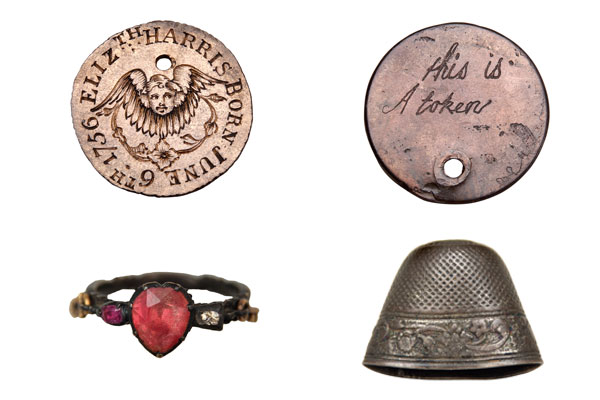‘Dear Sir, I am the unfortunate woman that lies under sentens of Death in Newgatt…’ So begins a letter of 1757 addressed to the powers that be at the Foundling Hospital in London’s Bloomsbury. Written in a strong hand, it contains the poignant petition of a woman on death row, Margaret Larney, that her children, who have been admitted to the hospital separately, might ‘know one and other’. Even if the younger child hadn’t died shortly after admission, Margaret’s eloquent plea would certainly have been in vain. When an infant entered the hospital, its former identity was erased and siblings remained ignorant of their blood ties.
But now, some 250 years later, Margaret is getting a second hearing. Her letter forms part of a small but compelling display of ‘tokens’ at the Foundling Museum, which is on the site of the former hospital. These are the everyday objects left by the desperate and destitute mothers in the mid-18th century who delivered their babies into the care of the Foundling Hospital. Hidden stories unfold through scraps of Georgian life that range from the quotidian— coins, keys, buttons, pieces of fabric, a hairpin — to the intriguing — a diminutive bone fish, a hazelnut — to the downright ghoulish: ‘Child 5588, John, renamed Robin Carr’ was admitted with a caul, a piece of membrane that can cover a newborn’s head and face and which is considered to be highly auspicious. Robin Carr needed all the luck he could get. Of babies taken in by the hospital about two thirds died.
On admission, a child was given a unique number as well as their new name. The document bearing his or her details (known as a billet) was used to wrap the token, which the mother had been advised to bring, in case she should ever be in a position to return to reclaim her offspring. (The mother’s name was not recorded by the hospital.) By identifying the object, she would prove that the child was hers. These miniature parcels, marked with the child’s admission date and number and sealed with wax, represented the hope that one day parent and child might be reunited. As such, they were powerful symbols of love, loss and longing.
Such apparently soulless bureaucracy on the part of the hospital — stripping a child of its birth identity and severing family ties — might seem harsh to a modern sensibility but for these newborns the alternative was infinitely worse than the prospect of an institutional life that might be lacking in love but which nevertheless offered basic schooling and the possibility of an apprenticeship. Still, the mothers, forced by circumstance to hand over their newborns, must surely have clung to the dream that they might one day be reunited with them (though in practice this seldom happened). Much was at stake, then, when it came to the choice of token. Often they were personalised — ribbons delicately embroidered, coins laboriously engraved or stamped — to ensure that they were distinctive and therefore easily identifiable.
Imagine the anguish of parents such as Mary Morris, mother of ‘Charlot, renamed Barbara Turner’, who returned after seven years with a carefully preserved copy of the letter she had left with her baby (many of the tokens were in written form such as letters or poems) only to find that her darling daughter had died shortly after admission.
Though they have a talismanic poetry and potency, it is not the objects themselves that make this such an absorbing display but the human drama and rich social history behind them. As war raged across Europe, and men went into battle leaving their womenfolk without support, hospital admissions increased. Many of the tokens bear witness to the devastating effects of military action and the hardship endured by wives and widows of soldiers. One note accompanying a token refers to a father ‘gone [for] a
soldier’.
The story of a male child, admitted at three weeks old, unfolds in the exhibit ‘Child 1495, James, renamed George James’, a billet with a note that reads ‘James Stewart, born the 10th May, his father on board St Albans’. His father, it seems, was John Stewart, boat master aboard HMS St Albans, a 60-gun man-of-war. His mother, presumably, had been forced to surrender him because of poverty. A friend of George’s father later turned up at the hospital to retrieve him but was met with the devastating news that the boy had died a year after admission.
Thankfully, there are happy endings too. ‘Child 10493, Oliver, renamed Luke Perkins’, admitted in 1759 with a yellow ribbon and a Charles II coin bearing the motto ‘Innocency in Safety’, the fleur de lys design, and, on the reverse, the initials of the child’s parents, RL and ED, was reunited with his birth parents four years later when his father provided an accurate and detailed description of the medal and the child’s birth name.
And though poor Margaret Larney was taken to Tyburn on a hurdle and executed by burning and strangulation (studies of the trial records suggest that she had been wrongly convicted), there is the merest hint of a silver lining: her older child, renamed George Millet, thrived and became apprentice to a wig-maker in Shropshire.






Comments